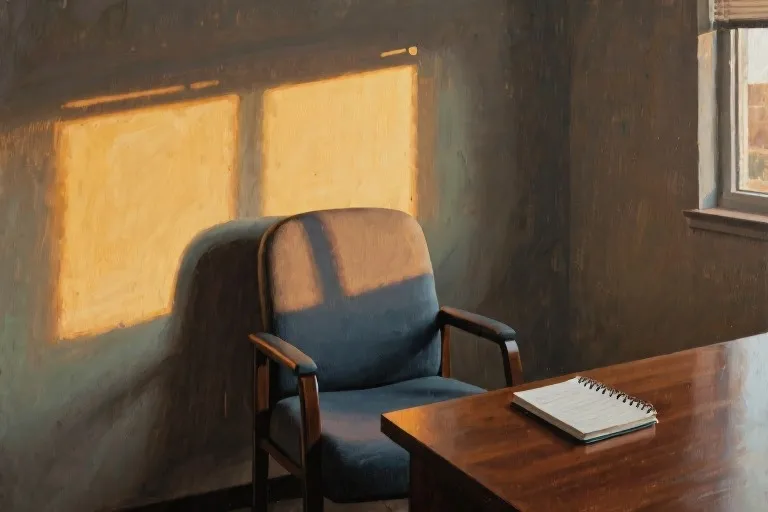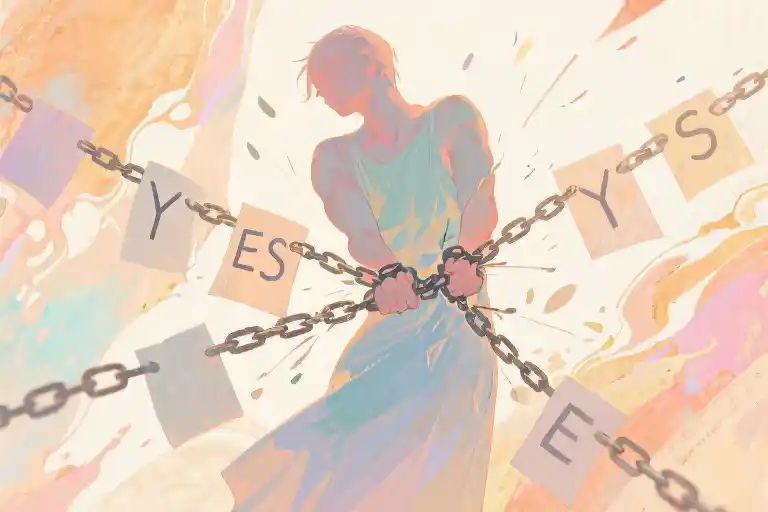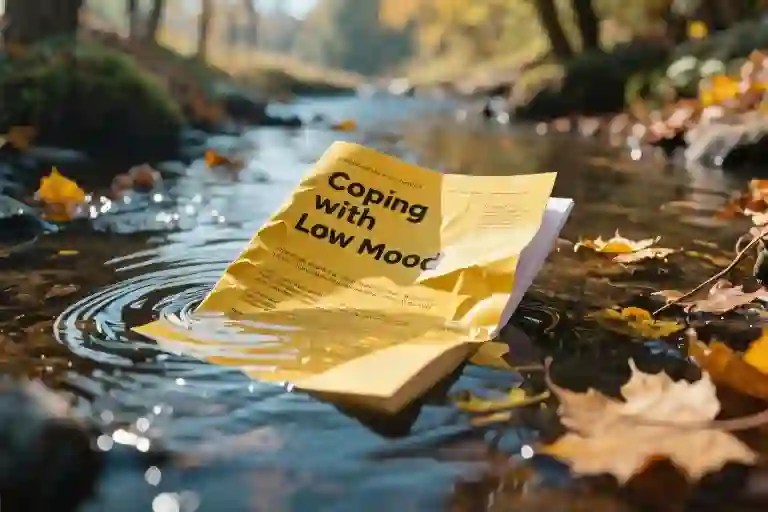The first prescription bottle sat on my nightstand in 1999 – back when dial-up internet screeched its way online and flip phones were status symbols. My psychiatrist assured me this was temporary, perhaps six months of medication to ‘recalibrate my brain chemistry.’ That amber plastic cylinder now feels like a museum artifact in a timeline spanning three U.S. presidents, four therapists, and approximately 11,680 doses of various SSRIs.
Anxiety doesn’t announce its permanence. It arrives wearing a guest’s smile, then quietly replaces your furniture, repaints your walls, until one morning you realize you’ve been living in its architecture for years. The buzzing isn’t a glitch – it’s the baseline hum of your operating system. The tightness in your chest isn’t temporary – it’s your body’s new vocabulary for existing.
We’ve been sold a dangerous fairy tale about mental health: that discomfort must always be transitional, that suffering requires an expiration date. But some of us wake daily to the same internal weather system – not storms to outrun, but climate patterns to navigate. My anxiety isn’t a chapter; it’s the font the story’s written in.
The Myth of Temporary
They’ll tell you anxiety is like a broken bone – set it right, give it time, the cast comes off. No one mentions that for some, it’s more like asthma. No cure, just management. No triumphant ‘after’ photo, just learning which altitudes you can breathe in.
Sensory Footprints
You might recognize these:
- That metallic taste flooding your mouth before your thoughts even form words
- Fingers that constantly seek textured surfaces like braille readers decoding danger
- Sounds arriving at your ears already amplified, as if someone cranked life’s volume knob
These aren’t malfunctions – they’re your nervous system’s dialect.
Twenty years teaches you the difference between fighting a condition and negotiating with it. I no longer wait for the day my brain stops its background commentary; I’ve learned to distinguish between the warning sirens worth heeding and the false alarms to acknowledge but disregard. The goal shifts from elimination to interpretation – reading your anxiety’s patterns like meteorologists study pressure systems.
This isn’t surrender. It’s the most radical form of self-awareness – building a life that accommodates your neurology rather than punishing it for noncompliance. The medications still fill my weekly pill organizer, but now they’re tools, not saviors. The therapy sessions continue, but we discuss harm reduction more than miracles.
Chronic anxiety management begins when we stop measuring progress by its disappearance and start recognizing the quiet victories:
- The morning you notice the buzzing first instead of last
- The decision made from preference rather than fear avoidance
- The moment you realize your anxiety has fingerprints – unique patterns you can learn to navigate rather than enemies to vanquish
If your hands have grown familiar with prescription bottles’ childproof caps, if your search history includes ‘why won’t my anxiety go away after 20 years,’ welcome to the club that meets in waiting rooms and pharmacy lines. The first rule? We stop pretending this is temporary. The second? We start building lives that fit our actual minds, not the ones self-help books promised us.
The Diagnosis Years: Waiting for Recovery
My medicine cabinet tells a story of hope and disappointment. Twenty-three prescription bottles lined up like soldiers, each bearing a different date but the same promise of relief. The earliest one—a faded orange container from 1999—still holds three remaining pills of the first SSRI I ever took. Back then, I kept it ‘just in case,’ never imagining this would become the opening chapter of a twenty-year chronicle.
The Good Patient Chronicles
September 12, 2002
“Dr. Reynolds says the new medication needs 6-8 weeks to work. Marked the calendar for November 1st—that’s when my real life begins. Did the breathing exercises three times today exactly as instructed. Bought organic chamomile. Followed all the rules. Why do I still feel the buzzing in my teeth when I try to sleep?”
March 8, 2007
“Third medication adjustment this year. The psychiatrist called me ‘highly compliant’—apparently that’s rare. If being a perfect patient was the answer, I should’ve been cured by now. Still, I’ll try the new cognitive restructuring worksheets tomorrow. Maybe this time…”
The pages of my journals document what medical charts never capture: the exhausting arithmetic of hope. Calculating the cumulative hours spent in therapy waiting rooms (1,840). The pounds gained from medication side effects (28). The exact shade of blue the yoga mat was when I finally admitted downward dog couldn’t downward-dog my anxiety away.
The Pharmacy of Broken Promises
Let me walk you through my shelf of might-have-beens:
- The Starter Pack (1999-2002): Fluoxetine, sertraline, paroxetine—the holy trinity of first-line treatments. Each came with a pamphlet listing potential side effects but never mentioned the unlisted one: the slow erosion of certainty that anything would work.
- The Augmentation Era (2003-2010): When monotherapy failed, we stacked pills like building blocks. Mood stabilizers that made the world feel wrapped in cotton. Beta-blockers that slowed my heart but not my thoughts. That peculiar year when we tried an off-label blood pressure medication—turns out lowering your diastolic number does nothing for existential dread.
- The Alternative Phase (2011-2015): The desperate pivot to supplements that promised to ‘rebalance GABA levels.’ Bottles of lavender oil that made my wrists smell like a spa but left my amygdala unconvinced. The $400 magnesium complex that worked exactly as well as the $7 generic version.
Here’s what twenty years of prescription bottles taught me: chronic anxiety laughs at our timelines. The six-week drug trials, the eight-session therapy packages, the thirty-day mindfulness challenges—they’re all measuring cups trying to contain an ocean.
The Turning Point
The moment of truth came not in a doctor’s office but at a CVS pharmacy counter. As the technician rang up my latest prescription refill, she remarked, “You’ve been on this one a while—since 2014, right?” The date hit me like a delayed diagnosis. I’d been taking the same ‘temporary measure’ longer than some marriages last.
That night, I laid out every medication bottle chronologically across my kitchen table. The resulting timeline looked less like a treatment plan and more like an archaeological dig through layers of unmet expectations. Each bottle represented a version of myself that believed recovery was just one perfect chemical combination away.
It was time to stop digging.
What emerged wasn’t surrender but something more radical: the understanding that my anxiety wasn’t a detour on life’s journey—it had become the very terrain I traveled through. The buzzing in my teeth, the weight in my chest, the hypervigilance that noticed every flickering fluorescent light—these weren’t symptoms to eliminate but sensations to navigate.
For those just beginning this realization, know this: letting go of the cure narrative doesn’t mean abandoning hope. It means transferring that hope from some imagined future where you’re ‘fixed’ to your present capacity to build a meaningful life within your actual neurology. Tomorrow we’ll explore what that rebuilding looks like—not with pill organizers, but with personalized survival architecture.
Next: The moment I stopped fighting my brain’s alarm system and started learning its language…
The Alarm System Without an Off Switch
For years, I kept searching for the master control panel – that mythical switch that would silence the relentless alarms in my nervous system. The realization came gradually, like dawn breaking over a lifetime of assumptions: some alarm systems aren’t malfunctions to be repaired, but highly sensitive equipment doing its job too well.
The Neuroscience of Untriggered Anxiety
Modern brain imaging shows us what our ancestors couldn’t see – an amygdala that lights up like Manhattan at midnight, even when no actual threat exists. Unlike trauma-induced anxiety with clear neural pathways, this variety operates like a smoke detector reacting to steam from your shower. The 2018 Harvard/MGH study on ‘non-specific threat response’ revealed that nearly 40% of chronic anxiety cases show no correlation with traumatic events, just an overactive detection system mistaking life for danger.
My neurologist once explained it using car alarm analogies: ‘Your brain’s like a luxury vehicle parked in a safe garage – the alarm keeps triggering not because of thieves, but because the sensitivity settings came preset too high from the factory.’ This framing helped me stop asking ‘Why am I like this?’ and start exploring ‘How does this particular system operate?’
A Sensory Dictionary of Anxiety
Auditory:
- The white noise of worry: not quite static, more like distant radio chatter with occasional clear phrases (‘they hate you’/’you’ll fail’)
- Volume fluctuations where normal sounds feel aggressively loud (cutlery clattering, keyboard typing)
- That peculiar silence when anxiety temporarily lifts – not peaceful, but suspicious, like the moment before a jump scare
Tactile:
- The infamous ‘anxiety sweater’ – not warmth but constant awareness of clothing against skin
- Phantom weights: an invisible hand pressing sternum, lead filling limbs during decision fatigue
- The ‘buzz’ – less vibration than cellular-level unrest, as if every molecule got caffeine
Vestibular:
- World tilting slightly when standing still (not dizziness, but perpetual off-balance)
- Time distortion where minutes crawl during attacks yet years vanish in retrospect
- Spatial disorientation in crowded places – not agoraphobia, but sensory triangulation failure
The Pivot Point: From Elimination to Management
The breakthrough came when I stopped viewing anxiety as software to debug and started seeing it as hardware to work with. Like left-handedness or perfect pitch, it’s simply how my system defaults operate. This isn’t surrender – it’s strategic adaptation:
- Recalibration: Adjusting life’s ‘sensitivity settings’ (less caffeine, more buffer time)
- Signal Sorting: Creating mental filters for real threats vs false alarms
- System Checks: Daily ‘diagnostics’ (am I hungry? tired? overstimulated?)
- Output Channels: Redirecting nervous energy into creative/work flows
What surprised me most? The same neural pathways that generate endless ‘what if’ scenarios also enable rapid pattern recognition and contingency planning – traits that serve me well in crisis management work. My ‘malfunction’ turned out to be a poorly understood feature.
Living With an Always-On Alert System
These days, I think of my anxiety as those earthquake early warning systems – sometimes triggered by passing trucks rather than tectonic shifts, but still valuable when properly interpreted. The alarms may never fully silence, but I’ve learned to:
- Decode their patterns (mornings are DEFCON 2 by default)
- Create mental ‘safe rooms’ (certain music, textures, smells that lower volume)
- Honor the system’s positives (hyper-vigilance saved me during actual emergencies)
Most importantly, I stopped waiting for some future version of myself who wouldn’t have anxiety. That person doesn’t exist – and the one who does has survived every worst day so far, alarms blaring and all.
Designing Your Survival Protocol
After decades of living with chronic anxiety, I’ve learned that management isn’t about finding a cure—it’s about creating personalized systems that work with your brain’s unique wiring. This isn’t a temporary fix; it’s architectural work for permanent residency.
Mapping Your Triggers
The most powerful tool in my survival kit wasn’t medication or meditation—it was my homemade trigger tracker. Unlike generic anxiety lists, this living document records:
- Sensory precursors: That metallic taste signaling an impending episode
- Time patterns: How 3:17 PM consistently brings cognitive static
- Environmental factors: Fluorescent lighting that makes my skin vibrate
Create yours by carrying a small notebook for two weeks. Note not just obvious stressors, but subtle shifts in:
- Body temperature
- Visual perception (colors appearing brighter/duller)
- Sound sensitivity
- Time distortion (minutes feeling like hours)
Environmental Leverage Points
We’ve been told to change ourselves to fit environments. For chronic anxiety, we must reverse this. These three adjustments made my apartment a sanctuary:
- Lighting infrastructure: Installed dimmable warm LEDs (3000K) with blackout backup
- Sound topography: Created “frequency zones”—white noise near windows, complete silence in the closet cocoon
- Escape routes: Always seating myself near exits in public spaces (the two-step rule)
Pro tip: Use painter’s tape to mark “safe angles” where you can see all room exits without neck strain.
Energy-Based Scheduling
Traditional productivity methods fail chronic anxiety sufferers because they assume consistent capacity. Try this instead:
The Wave Method
- Track mental energy fluctuations for 14 days
- Identify your 3-hour “clear window” (mine’s 10:30AM-1:30PM)
- Build your daily schedule like ocean waves:
- High tide: Demanding cognitive work during clear windows
- Ebb flow: Administrative tasks as energy declines
- Low tide: Mandatory non-screen recovery periods
My current template looks like:
8:00-10:00 - Body maintenance (meds, food, gentle movement)
10:30-1:30 - Deep work (protected time)
2:00-4:00 - Meetings (camera optional)
4:30-6:00 - Sensory reset (walking, tactile activities)
7:00+ - Passive input only (audiobooks, dim lighting)The Emergency Toolkit
Every chronic anxiety survivor needs these always accessible:
- Physical:
- Ice pack (for sudden facial flushing)
- Sour candy (interrupts panic loops)
- Textured fabric swatches
- Digital:
- Pre-written crisis text to trusted contact
- “Safe space” photo album
- Offline list of grounding techniques
Remember: These aren’t failure indicators—they’re the seatbelts you always keep buckled.
Maintenance Over Miracles
After twenty years, I’ve stopped chasing breakthrough moments. My most effective strategies are boringly consistent:
- Weekly:
- Medication check-in (even when feeling “fine”)
- Trigger map updates
- Environment tweaks (new air filter, bulb replacement)
- Monthly:
- Energy pattern review
- Toolkit refresh (replace expired items)
- One small comfort upgrade (better headphones, weighted blanket)
This isn’t about defeating anxiety—it’s about building a life where it doesn’t get to dictate the terms. The goal isn’t to wake up without it someday, but to wake up knowing exactly how to live with it today.
Redefining Recovery: Anxiety as an Information Processing System
For years, we’ve been sold the idea that recovery means complete elimination of anxiety symptoms. What if we’ve been measuring progress all wrong? Emerging neuroscience suggests anxiety may represent an alternative information processing mode – not a defective one. This cognitive framework could transform how we approach chronic anxiety management.
The Adaptive Brain Hypothesis
Research from Harvard’s Center for Brain Science reveals anxious brains demonstrate:
- Enhanced threat detection: 23% faster processing of potential dangers (Study: Journal of Neuroscience 2021)
- Detail-oriented perception: Superior recall of environmental minutiae
- Hyper-connected neural networks: Particularly between amygdala and prefrontal cortex
These traits, while exhausting, served evolutionary purposes. Our challenge isn’t deleting this wiring but learning to harness its strengths while mitigating distress.
Practical Applications
Consider how your anxiety traits might translate:
| Anxiety Symptom | Potential Strength | Implementation Strategy |
|---|---|---|
| Overpreparation | Contingency planning | Channel into project risk assessment |
| Sensory sensitivity | Environmental awareness | Use for creative fields like photography |
| Rumination | Deep processing | Apply to analytical tasks |
Neurodivergent advocate Dr. Devon Price notes: “When we stop pathologizing difference, we discover unexpected competencies.”
Your Neurodiversity Toolkit
- Cognitive Reframing Exercise:
- Identify 3 situations where your anxiety traits provided unexpected benefits
- Note how these differ from neurotypical approaches
- Environmental Optimization:
- Create “high-focus zones” with controlled sensory input
- Develop personalized early-warning systems for overload
- Productivity Alignment:
- Schedule demanding tasks during natural alertness windows
- Build in recovery periods matching your cognitive rhythm
Self-Assessment: Is This Working For You?
Rate these statements (1-5):
- I recognize specific contexts where my anxiety traits become assets
- My daily routines accommodate rather than fight my neurology
- I can identify at least two professional applications for my heightened awareness
Scoring:
12-15: Strong adaptive framework
8-11: Developing recognition
<7: May need additional reframing tools
Remember: This isn’t about glorifying suffering, but acknowledging that living with anxiety long-term requires redefining success. As researcher Dr. Temple Grandin reminds us: “The world needs different kinds of minds working together.” Your anxiety management journey might look less like recovery and more like discovering how to collaborate with an unconventional but valuable cognitive partner.
The Climate System Within
My anxiety isn’t a storm to outrun—it’s the atmospheric pressure of my internal weather. Some days hover at partly cloudy with manageable winds, others bring unexpected squalls that rearrange my plans. This isn’t failure; it’s meteorology. Your nervous system has its own forecast patterns too, complete with unique pressure systems we’re only learning to predict.
Your Anxiety Fingerprint
What does your mental weather report sound like? Maybe:
- “Scattered brain fog with afternoon decision paralysis”
- “High alert conditions continuing through weekend social events”
- “Patchy motivation with intermittent productivity bursts”
Grab any notebook (phone memos work too) and sketch today’s forecast. Not to fix it, but to observe—like a scientist tracking migratory patterns. Over time, you’ll spot your personal:
- Early warning signs (that humidity-before-rain feeling)
- Safe pressure zones (activities that ease the barometric drop)
- Storm preparation rituals (your psychological boarding-up)
The Long-Term Forecast Community
Twenty years of living with chronic anxiety taught me this: we need weather stations, not emergency rooms. That’s why we’ve built The Adaptation Network—a digital space where:
- Members share personal “climate maps” (not symptom lists)
- Veteran “weather observers” offer decade-tested coping strategies
- No one asks “when will you be cured?” because we understand atmospheric shifts
Join us at [community link]—not for solutions, but for the profound relief of standing in someone else’s rain without needing to explain your own. Bring your forecast journal; we’ll trade notes on surviving the seasons.
The first rule of our club? You don’t have to pretend it’s sunny.





